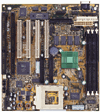
|
Opti The Super7 platform isn't once what it used to be. Just a little while ago (ahhhh... nostalgia) just about every single CPU on the market had its home in that lovely little Socket 7 interface we have all come to know and sometimes love
65% Rating: 
|
|
|
|
Home >
Reviews >
Motherboards >
ASUS P5S-B |
|
|
Asus P5S-B Super Socket 7
Motherboard Review
 Opti
The Super7 platform isn't once what it used to
be. Just a little while ago (ahhhh... nostalgia) just about every single CPU on
the market had its home in that lovely little Socket 7 interface we have all come
to know and sometimes love. Opti
The Super7 platform isn't once what it used to
be. Just a little while ago (ahhhh... nostalgia) just about every single CPU on
the market had its home in that lovely little Socket 7 interface we have all come
to know and sometimes love.
From the Pentium/Pentium MMX, K5, K6, 6x86
and the rest of the gang all shared one thing in common. Of course, processors
like the Alpha and Motorola's 680x0 never had a place in Socket 7 to begin with
but since they are not x86 based, who cares? Life was easier back
then.
Upgrade options were limited to one platform and we never had to worry about whether or
not our socket would still be supported as widely as it is
or was because everyone was using it.
Times have changed, some say for the bad,
others for the good. With such a wide range range of processor interface,
motherboard manufacturers really do not have much of a choice of which platform
to support. Most of them go in for what's popular, because that is what sells.
The few of them out there still make older Socket 7 boards, though newer models
may be scarce. AMD has recently announced their 550MHz version of their popular
K6-2 processor.
At
about the same time, VIA/Cyrix unveiled their Joshua line of microprocessors
which are slated to do combat with the Intel Celeron CPU. But guess what? The
Joshua isn't on the Socket 7.
It is on
Socket 370 and designed as a complete replacement for the Celeron CPU. The older
MII CPUs are still being sold, but there doesn't seem to be any plans for future
progression of the CPU. So what does that mean? It means that AMD is the only
manufacturer left out there that still provides Socket 7 CPUs and that has
delivered higher clock speed versions on a regular basis. How long will they
keep this up? Only time will tell. Until then, no need to shed any tears because
Super7 isn't dead just yet...
Reviewed here on PCStats is the Asus
P5S-B "Super 7" motherboard based upon a chipset from SiS (Silicon Integrated
Systems), the SiS 530 / 5595 chipset to be
exact.
Specifications
- Based upon the SiS 530 / 5595 chipset. SiS 530
provide on board hardware 2D/3D VGA acceleration
- Supports AMD K5 / K6 /
K6-2 / K6-3, IBM / Cyrix 6x86MX / MII, Intel Pentium / Pentium MMX (P55C, P54C,
P54CS)
- Ultra ATA/66 bus mastering support
- Support for 66, 75, 90, 95,
100, 105 and 112 MHz Front Side Bus (FSB) speeds
- Provides support for
Synchronous / Asynchronous bus clock speed settings
- 512KB pipelined burst
SRAM L2 / L3 cache. (1024KB optional)
- 3.3V x 3 DIMM slots for up to 768MB
RAM.
- AGP 2X through the SiS 530 on board AGPset
- 4 PCI/ 2 ISA / 0 AGP
(on-board)
- 1 PS/2 or USB or IrDA header (one connector for all
devices...shared)
- Onboard Audio (optional)
- PC Health Monitoring
through SIS 5595 South Bridge chip
- Desktop Management Interface (DMI)
-
AT form factor with dual AT/ATX power connectors
- Symbios SCSI BIOS
-
Header for an LCD flat panel display
What's
Included
A great user's manual, 1 ATA/66 cable,
standard floppy drive connector, 2 COM port attachments, 1 PS/2 mouse port -
parallel port cable, 1 VGA cable with connects to the on-board VGA header, bag
of spare jumpers and an installation CD with pretty handy applications. Other
than that, nothing to really make headlines on the New York
Times.
|

